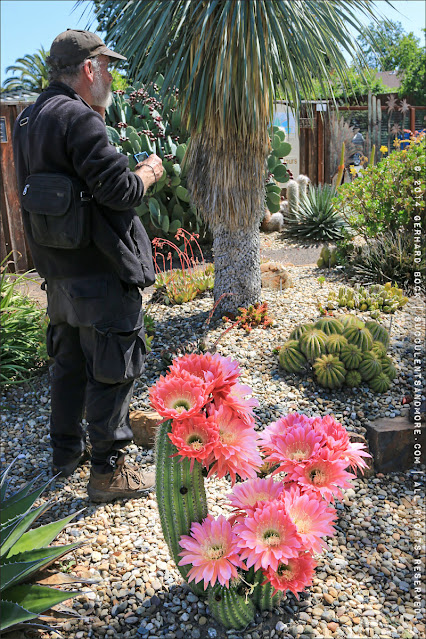'Flying Saucer' flying high
I vividly remember the first time I saw Echinopsis ‘Flying Saucer’ in flower. It was at the Ruth Bancroft Garden in April 2014:
I couldn’t believe how many flowers were open at the same time, and how massive they were!
Fast forward to the present. After a long quest trying to track down Echinopsis ‘Flying Saucer’, I finally found one last year at Bach’s Cactus Nursery in Tucson, Arizona. And on May 18, 2022 it flowered for the first time:
The flower was a full 6 inches across. Here’s my wife’s hand for scale:
Out of all the cactus flowers I’ve seen, ‘Flying Saucer’ might just be my favorite. It’s easy to see why:
The photos above were taken at 9 a.m. when the flower was still in the shade. In the images below, taken at 10 a.m., it’s sidelit by the sun:
Echinopsis flowers are notoriously short-lived. ‘Flying Saucer’ is no exception. This is what the flower looked like at 4 p.m.:
By the next morning, the flower had collapsed completely:
As they say, the higher they fly, the harder they fall.
As much as I want these flowers to last for more than a day—or, in this case, half a day—I’m afraid they might lose some of their mystique if they did.
About Echinopsis ‘Flying Saucer’
Echinopsis ‘Flying Saucer’ grows to a height of approximately 30 inches, with stems up to 5 inches in diameter. It’s hardy to 25°F.
About the genus Echinopsis
The genus Echinopsis, the way it is currently classified, combines a large number of previously separate genera, including Trichocereus and Soehrensia, the parent genera of ‘Flying Saucer’. As is so often the case in taxonomic circles, there’s a great deal of controversy around this classification. It’s easy to see why: As a catch-all genus, Echinopsis encompasses 120+ species ranging from the tiny peanut cactus (Echinopsis chamaecereus) to the towering Argentine saguaro (Echinopsis terscheckii). Are they really that closely related that they should be in one genus? I suspect that further DNA studies will lead to the reestablishment of many of the previous genera.
© Gerhard Bock, 2022. All rights reserved. To receive all new posts by email, please subscribe here.












Glorious! What an unbelievable cactus. A great gift and legacy left to all cacti lovers by Hans Britsch.
ReplyDeleteWhat I find most remarkable is that despite the very short bloom time, you won the 'cactus lottery' on that faithful day in April 2014 when you saw it in full bloom in the Ruth Bancroft garden. (Unless you had inside information and got a phone call to show up!).
chavli
Total coincidence :-)
DeleteSpectacular!
ReplyDeleteWait a minute -- your wife has awfully nice hands, so I assume you're doing most of the digging ;). That's a fabulous echinopsis, no mistake. It was obviously destiny that you two should meet, Gerhard!
ReplyDeleteGloves work wonders :-)
DeleteIt's an incredible flower. I hope the plant lives long and prospers in your garden.
ReplyDeleteMe too!
DeleteJust stunning. I agree with earlier comments - how lucky you were to stumble upon that plant, blooming its head off on that fateful day at RBG?!
ReplyDeleteWow! Worth the wait. With flowers that large can see why they are short lived. Must take a tremendous amount of energy to pump out something so large.
ReplyDeleteFortunately, they do flower repeatedly throughout the summer. I also fertilize my Echinopsis hybrids with Espoma Flower-Tone - the only cacti of mine that get special treatment like that, ha ha.
DeleteCan I eat or.make.tea from.the flower.
ReplyDeleteI don't know, but I wouldn't recommend it.
DeleteI was good friends with Hans and on three separate occasions over 15 years, I asked him how he created this amazing cross. Each time I asked I got a different story. I also asked many of his workers if they knew and they said is was something Hans did not want others to know. Maybe his son Thomas knows, but the jury is still out on how this amazing hybrid was made. Hans was a very inspirational person to me. I am following in his footsteps and have created thousands of my own hybrids. If you want to see them go to torchcactus.com for more information.
ReplyDeleteBrent, you've taken up the torch from Hans (no pun intended) and are continuing his legacy. Nobody else in the U.S. is doing what you're doing!
Delete